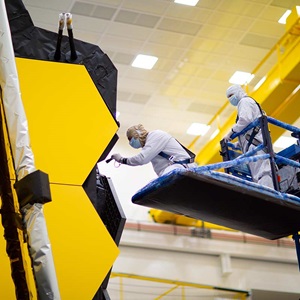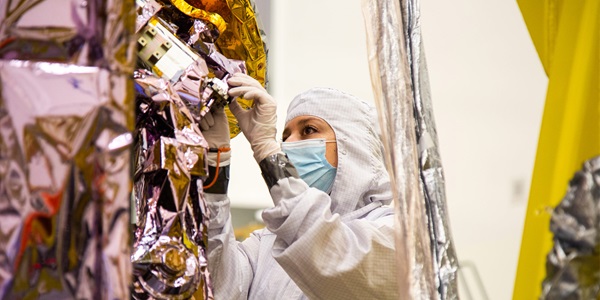Digital Modeling for Out-of-This-World Environments

By: Kelly McSweeney
It's hard enough to keep a patio umbrella safe on a windy day on Earth. So, what happens when a razor-thin umbrella the size of a tennis court hitches a ride to space on a noisy, bumpy rocket?
When space is out of reach, engineers use digital modeling to simulate space environments. The team that designed and built the James Webb Space Telescope has been testing and modeling the telescope's structure for over a decade to successfully reach it final home at Lagrange point 2 (L2) about a million-miles away from Earth.
Engineers use digital modeling and real-world physical tests to find out what could go wrong and put solutions into place.
"I verify and validate the structural integrity of main load-carrying components to make sure they meet standards and are acceptable for flight," says Javier Lopez, a structural analyst assigned to Webb. "I make sure that things don't break when the vehicle is ascending into space and throughout the life of the mission."

Things Get Heated
Webb is truly one of a kind. It will uncover galaxies that have been hidden from our view and seek to answer fundamental questions about the origins of the universe. To meet this gargantuan challenge, it is the largest, most powerful and most complex space telescope ever built and launched into space.
It simply is not possible to test it in space. However, engineers needed to find out what will happen during the launch so that they can prevent any scenario that could go wrong. One of the biggest challenges to the structure is the high vibration during launch.
"For instance, when the telescope is all packed in and stowed in the launch vehicle, it's a controlled chaotic, violent event," says Lopez. He adds, "We made sure that it will stay in one piece during that event."
Another concern is the large thermal gradient. Lopez explains that the side of Webb that faces the sun could be 350 degrees Fahrenheit, while the sun shield keeps the other side cold enough for the scientific instruments to perform, which is near absolute zero (zero Kelvin, or –459.67 Fahrenheit).
"We spend a lot of time simulating and validating on Earth so that we can accurately quantify those events. We have to design and qualify the spacecraft to that environment," Lopez says.
The sun shield is a critical component of Webb. Its membrane is made of five layers that are precisely stacked at specific angles for optimal performance. The main layer is 0.002 thousandths of an inch, and the remaining four layers are each 0.001 inches.
"We have to verify and prove that once it's all deployed and stretched out in space, it will perform the intended use even at those extreme temperatures," says Lopez.

Digital Modeling to Mimic Zero G
If the extreme temperatures deform the membrane, the layers could bow out and touch each other, causing problems for the spacecraft. By simulating these scenarios, the engineers can then build solutions to these challenges right into the design.
For reassurance, Northrop Grumman teams spent years developing analytical methods, 3D simulations and large 3D models to validate the simulations. First, they used analytical computation to simulate how the sun shield would behave on Earth. Then, they tested a physical model to validate the simulations.
"Although we're not going to test in a gravity-free environment, we can then make the extrapolation to say that those models will be adequate in predicting the behavior of the structure in space," Lopez says.
They used finite element analysis — a computerized method for predicting how something will react to physical effects such as vibration and heat.
"There are years and years of trust in the methodology," says Lopez. "It's a very reliable, analytical method that has been correlated year after year in the aerospace industry."
For Webb, this trusted digital modeling method is anchored with real-world testing to validate predictions and ensure success.
More innovation stories
Read all stories about advanced technology and innovation >>

